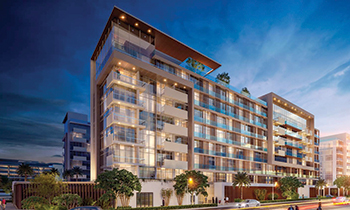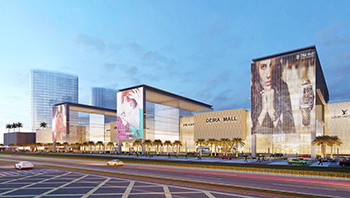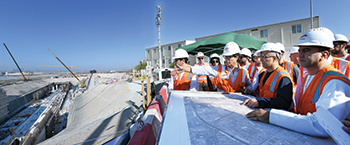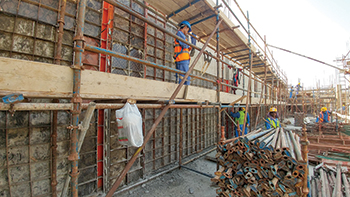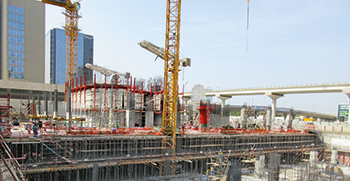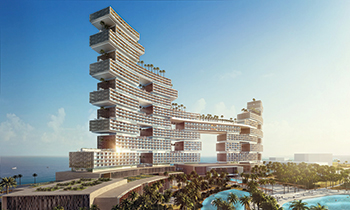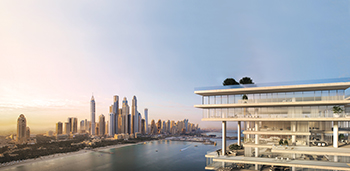
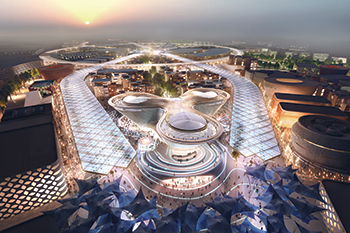 The Mobility pavilion ... being developed by Emaar Properties.
The Mobility pavilion ... being developed by Emaar Properties.
The Expo 2020 site is abuzz with activity. A host of contractors, consultants and suppliers are working with Expo 2020 to deliver an exceptional destination capable of handling 25 million visits between October 2020 and April 2021.
While the 4.38-sq-km site is unmistakably busy at ground level, the full extent of construction progress is perhaps best appreciated from above. Drone footage released in February shows structures springing up throughout the site’s three petal-shaped themed districts. It also shows the path of the Dubai Metro Route 2020 link which is clearly visible, extending northeast towards central Dubai.
Al Wasl Plaza, Expo 2020’s 150-m-diameter centrepiece, connects all of these elements. This huge central hub is currently abuzz with construction equipment working to set the stage for what’s to come.
Located in the heart of Dubai South, the Expo masterplan features an array of structures that, organisers hope, will provide lasting experiences for millions of visitors, and live on long after the event.
During the Expo, the themed districts will accommodate pavilions of participating countries, non-governmental organisations (NGOs) and Expo 2020’s commercial partners. Each district will be anchored by a theme pavilion focused on one of Expo 2020’s three subthemes: Opportunity, Mobility and Sustainability. In total, the themed districts and their buildings will boast a gross floor area (GFA) of 222,000 sq m.
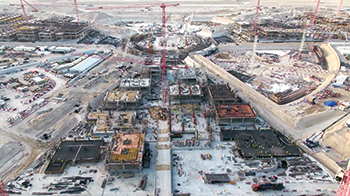 |
|
The Expo 2020 construction site ... an aerial view. |
Al Wasl Plaza’s seven entrances and exits will connect the site’s themed districts and other main concourses, including the Dubai Metro Route 2020 link and the falcon-inspired UAE Pavilion, designed by renowned Spanish architect Santiago Calatrava.
A domed trellis inspired by the Expo 2020 logo, stretching 130-m wide and 67.5-m high, will form the focal point of Al Wasl Plaza. An immersive, 360-degree projection surface should ensure an unforgettable visitor experience.
On track
Successfully delivering a masterplan of this magnitude is a complex task; to achieve this, the developers of Expo 2020 have assembled some of the world’s best design, construction and urban planning experts to ensure that the site is ready to welcome the world on October 20, 2020. Despite the scale of this undertaking, Expo’s Real Estate and Delivery team is on track to finish construction with plenty of time to spare for testing and other event operation preparations.
Ahmed Al Khatib, senior vice-president of Real Estate and Delivery at Expo 2020, tells Gulf Construction: “We are committed to finishing major shell and core construction a full year before the event opens to the public. Work is proceeding as planned and is on track.
“All major design work is nearing completion and the main construction phase is well under way. The three themed districts that form the core of the Expo site are taking shape rapidly.”
An on-site concrete batching plant opened in January 2017 to support construction activities. As of November 2017, recycled concrete had been used to construct more than 17 km of roads to provide site access for equipment and materials. Across the site, about 6,100 cu m of concrete is being laid every week.
Construction related to Expo 2020 is expected to reach its peak towards the end of 2018 and early 2019, when the number of people working on site will almost triple to 35,000 from 12,000 now.
Boost for businesses
The development of Expo 2020’s site is already having a positive economic impact, benefiting local, regional and international companies of all sizes. Expo 2020 is working with major construction firms such as Al-Futtaim Carillion, Laing O’Rourke, Khansaheb, Orascom Besix, Arabtec, Al Naboodah Construction, and Tristar Engineering to build what will be an exceptional World Expo site.
Hopkins Architects, in partnership with Turner & Townsend, is working as lead consultant for the site’s themed districts, and Emaar Properties is development manager for the Expo’s Mobility and Sustainability pavilions.
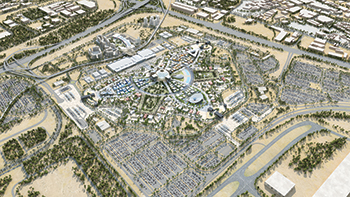 |
|
The masterplan covering an area of 4.38 sq km ... 25 million visitors expected at Expo 2020 between October 2020 and April 2021. |
In January 2017, Expo 2020 unveiled details of its Sustainability Pavilion, designed by Grimshaw Architects. It explores the potential for buildings to be self-sustaining in water and energy usage by employing innovative combinations of technologies to harvest solar power as well as water from humidity in the air.
Dubai-headquartered real estate developer Meraas is managing design and procurement activities for Al Wasl Plaza, which was designed by Adrian Smith + Gordon Gill Architecture. In November 2017, Expo 2020 awarded Abu Dhabi-based Cimolai-Rimond ME the contract to build Al Wasl Plaza’s steel trellis dome.
In January 2018, Expo 2020 awarded two construction contracts, worth a combined Dh670 million ($182 million), to Laing O’Rourke. Under the terms of the agreement, the contractor will build Expo’s Leadership and Media pavilions, the ‘Hammerhead’ access road to Al Wasl Plaza, and landscaping. It will also be responsible for associated mechanical, electrical and plumbing (MEP) works.
In keeping with the subthemes of Opportunity and Sustainability, construction companies are working with Expo 2020 to ensure environmental and economic best practices are followed.
For example, the US Green Building Council’s (USGBC) Leadership in Energy and Environmental Design (LEED) platform encourages the creation of healthy, highly efficient and cost-saving green buildings, and all of Expo 2020’s buildings have been designed to meet or exceed LEED Gold standards.
Expo 2020 is also working with its project team to achieve site-wide design and construction certification from CEEQUAL, the world’s first sustainability rating scheme for infrastructure.
The majority of Expo 2020-built construction contracts have now been awarded, and tenders for parks, overlay and public realm works are due to be floated in the coming months.
In terms of economic benefits, Dh10.8 billion of construction contracts and Dh411 million of non-construction contracts were awarded in 2017. To date, Expo 2020 has awarded 2,926 contracts – both construction and non-construction – with small- and medium-sized enterprises (SMEs) continuing to represent a priority, winning 1,645 of these deals.
Lasting legacy
From the very beginning, Expo 2020 has been committed to building a legacy that is meaningful and sustainable, extending its impact and benefits beyond the UAE to the wider region and the rest of the world. Expo 2020’s legacy is based on four pillars: physical, economic, social and reputational.
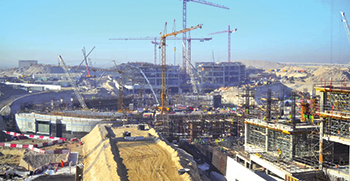 |
Construction is expected to peak towards the end of 2018 and early 2019, when the number of people on site will almost triple to 35,000. |
A large part of this strategy involves the site’s transformation after the World Expo. In September 2017, Expo 2020 unveiled its exciting plans for the site, which will become District 2020 – a highly accessible, well-connected urban development that will continue Expo 2020’s mission to ‘Connect, Create and Innovate’.
District 2020 will be a world-class mixed-use development and integrated community. It will reuse 80 per cent of Expo 2020’s built environment, inheriting the World Expo’s iconic architecture and advanced digital and physical infrastructure.
Located next to Al Maktoum International Airport, District 2020 will be connected to Dubai Metro and major highways, making it easily accessible from the UAE’s major air and sea ports. The urban development will include 65,000 sq m of residential space and 135,000 sq m of commercial space in a location that will become home to innovation, educational and entertainment facilities, as well as a conference and exhibition centre developed by Dubai World Trade Centre (DWTC).
International firms including Siemens and Accenture have already committed to District 2020. Siemens will establish its global headquarters for airports, cargo and ports logistics at the site, and Accenture will open a digital hub in District 2020.
The Sustainability Pavilion has already been designed with its post-Expo future in mind. It will continue to benefit society as a Children and Science Centre, encouraging an appreciation of science and nature among youth in the UAE. Expo’s Leadership and Media pavilions will become hotels during the legacy phase.
Once the Expo site’s transformation is complete, District 2020 will be home to an array of social and cultural attractions, recreational spaces, not to mention the iconic Al Wasl Plaza.
The site’s physical transformation from Expo 2020 to District 2020 will begin immediately after the Expo. Work is scheduled to commence on 11 April, 2021 and initial repurposing is expected to take six to nine months to complete.
Marjan Faraidooni, senior vice-president of Legacy Development and Impact at Expo 2020, says: “Beyond 2020, Expo will continue to contribute to new business generation, GDP growth and job creation across the region. It presents us with an immense opportunity to create an integrated ecosystem that will support innovation and attract not only businesses but also visitors and residents.
“In terms of its physical legacy, the Expo site has been designed from the start with its future, as District 2020, in mind. As a community of connected minds created for future generations, District 2020 will further contribute to the realisation of Expo 2020’s overall theme: ‘Connecting Minds, Creating the Future’.”





















_0001.jpg)


.jpg)
















.jpg)








.jpg)



